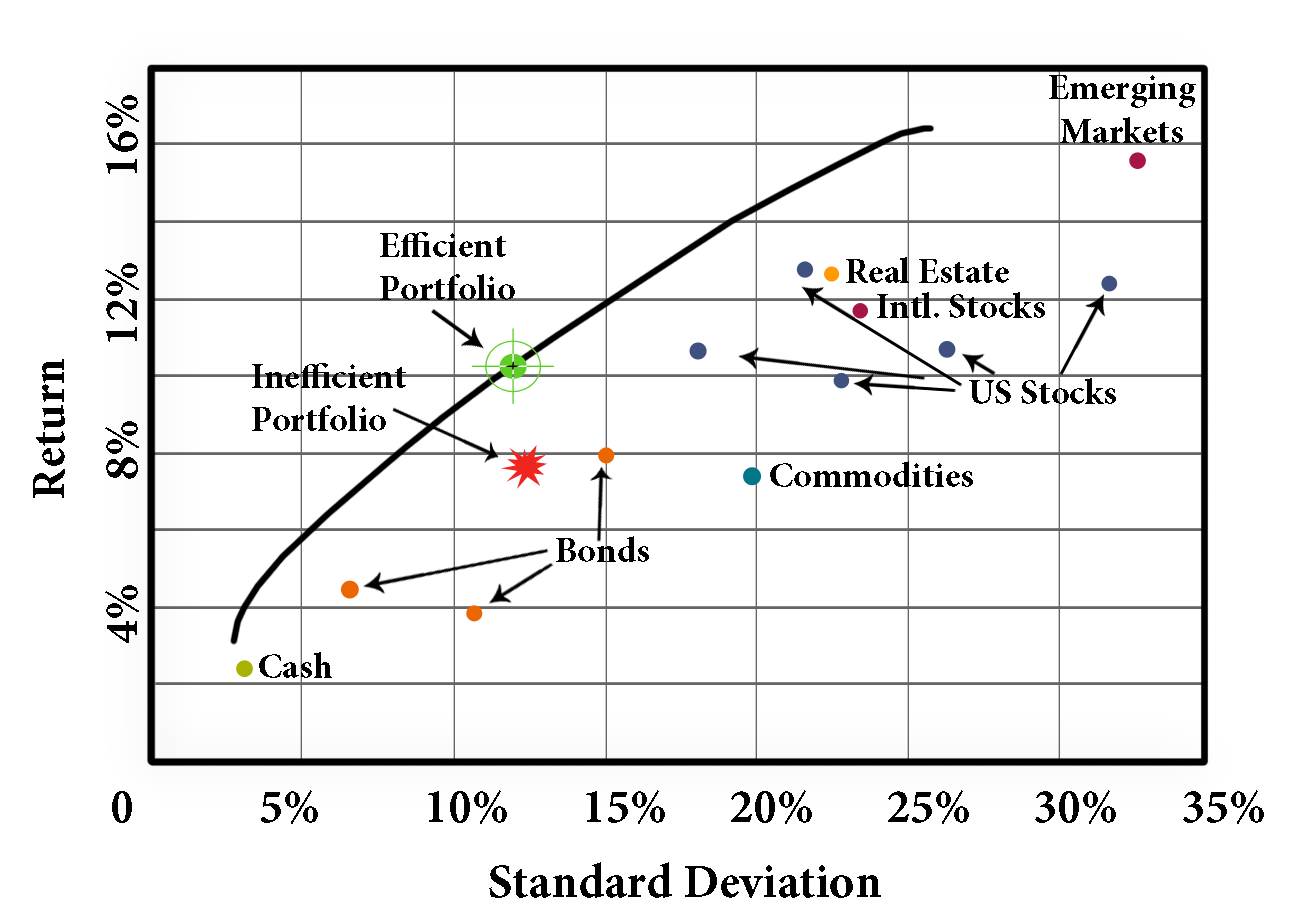Efficient Frontier
The efficient frontier
 In 1990, Harry M. Markowitz won a Nobel Prize in Economic Sciences. Throughout his professional life, he studied investment risk, return, correlation, and diversification. His theories are the basis of what we know today as “Modern Portfolio Theory”, or “MPT”.
In 1990, Harry M. Markowitz won a Nobel Prize in Economic Sciences. Throughout his professional life, he studied investment risk, return, correlation, and diversification. His theories are the basis of what we know today as “Modern Portfolio Theory”, or “MPT”.
MPT is well-known in the investment community as a basis for sound portfolio management principles. It should serve as a foundation for your investment plan as well.
The cornerstone of MPT is the relationship between investment risk and return. Those factors are charted on what we call the “efficient frontier”.
Understanding the concepts behind creating an efficient investment portfolio lays a great foundation for successful long term investing.
The efficient frontier
The efficient frontier illustrates a securities expected return and the risk associated with achieving that expected investment return. On the left side of an efficient frontier graph (the Y axis) is the expected investment return plotted vertically. The horizontal footing (the X axis) is a measurement of a securities expected risk (illustrated by standard deviation).
The efficient frontier is an arch which gently slopes upwards, starting from the lower left corner and fading into the upper right corner. The line represents multiple portfolio possibilities providing the maximum portfolio return with the least risk possible.
The calculations to reach an efficient portfolio are complex, and as much of an art as a science. They’re based on a set of risk/return assumptions and expectations. Those factors may be grounded in past results, predictive of future expectations, or a combination of both.
The efficient frontier (12/31/2014)[1]
The green bull’s eye is an efficient portfolio. It’s the optimal combination of asset classes to generate the highest level of investment return for that specific level of investment risk.
The starburst symbol below and right of the optimal portfolio is an inefficient investment portfolio. It’s risk level is higher than the optimal portfolio, and it’s expected return is over 2% less. This portfolio can be improved with an optimal combination of asset classes.
The other dots are individual asset classes. Emerging markets has the highest potential returns with the highest level of risk. It’s plotted to the far top right corner.
NOTE: The dots on the chart above are entire groups of similar securities, otherwise known as asset classes. Individual securities are too volatile and inconsistent to add to the efficient frontier scatterplot above. Learn more about systematic risk and non-systematic risk here.
The cash asset class is plotted in the lower left corner. It has the lowest level of risk and lowest expected returns. The other dots plotted in seemingly random fashion throughout the grid are asset classes such as large company stocks, intermediate term bonds, and commodities.
A combination of asset classes reduces overall portfolio risk and can increase returns
Notice all individual asset classes are plotted below the efficient frontier line. Asset classes are not efficient on their own; they must be combined with other asset classes to improve the risk/reward characteristics of the overall portfolio.
|
Your portfolio is like banana bread. You must have all of the components in the right amounts to get the best results like when my wife makes her amazing banana bread. The bananas are almost rotten, sugar alone is too sweet, uncooked flour isn’t edible, and who wants to eat straight butter? But when she works her magic, the banana bread always turns out spectacular!The efficient frontier is used as a guide to help allocate your investment assets. We call this process asset allocation. Asset allocation is an imperfect science, however, because no one can predict the future. If you could predict the future, you would allocate 100% of your investments to the best performer for each future time period. Rather, asset allocation seeks to reduce risk and achieve an investment return appropriate for your financial goals. While imperfect, it’s the only prudent strategy.
Is your investment portfolio efficient?
Unfortunately, most investors have highly inefficient portfolios. They’re taking more investment risk than is necessary and getting less in return. This is to be expected however, because most investors don’t have the sophisticated software and analytical tools necessary to create efficient asset allocation models. The efficient frontier is based on historical performance or future projections. In the short run performance, both risk and return can vary widely. Over long periods of time, the variations narrow and the efficient frontier becomes much more relevant to your investment planning. Your asset allocation may require adjusting from time to time. While no one can predict market movements, I’m a big believer in reversion to the mean. The best performing asset classes will fall back to earth, and worst performers will soon outperform. Periodically lightening up on great performers and overweighting underperformers makes a great deal of sense. It’s what we call “contrarian investing”. While asset allocations may be adjusted periodically, I never do this more than once per year, and only at a regularly set time. If I were randomly making these allocation changes, my expectations for the future may be jaded by recent events which can easily lead to poor decision making. By making these “tweaks” on a scheduled annual basis, I’m all but assured of rational decisions based on the long term expectations, rather than short term noise.
The efficient frontier in summary
There’s not a whole lot an individual investor can do with the efficient frontier unfortunately. Unless you have the software and time to figure it out, the efficient frontier is valuable as a concept only. The good news is even as just a simple concept, the efficient frontier can help you make great diversification decisions. Understanding that combining asset classes in varying amounts can improve investment performance provides a great foundation for your long term investing success.
About the author
Greg Phelps, CFP®, CLU®, AIF®, AAMS® is a 20+ year financial planning veteran specializing in retirement transition and decumulation. His firm, Redrock Wealth Management, is a fee only fiduciary planner in Las Vegas.
[1] Source: Morningstar® Direct. |

